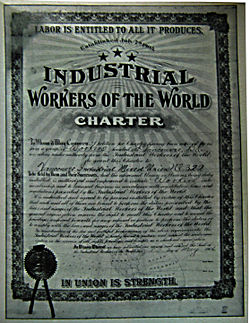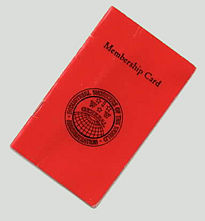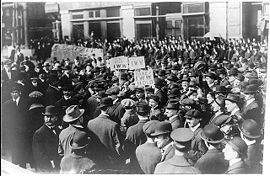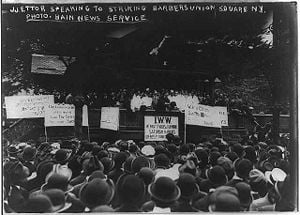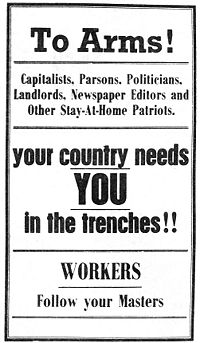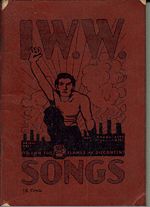Industrial Workers of the World
| File:Label.png | |
| Industrial Workers of the World | |
| Founded | 1905 |
|---|---|
| Members | 2,000/900 (2006) 100,000 (1923) |
| Country | International |
| Office location | Cincinnati, Ohio |
| Website | www.iww.org |
The Industrial Workers of the World (IWW or the Wobblies) is an international union currently headquartered in Cincinnati, Ohio, USA. At its peak in 1923 the organization claimed some 100,000 members in good standing, and could marshal the support of perhaps 300,000 workers. Its membership declined dramatically after a 1924 split brought on by internal conflict and government repression. Today it is actively organizing and numbers about 2,000 members worldwide, of whom roughly half (approximately 900) are in good standing (that is, have paid their dues for the past two months). IWW membership does not require that one work in a represented workplace, nor does it exclude membership in another labor union.
The IWW contends that all workers should be united within a single union as a class and that the wage system should be abolished. They may be best known for the Wobbly Shop model of workplace democracy, in which workers elect recallable delegates, and other norms of grassroots democracy (self-management) are implemented.
Founding
The IWW was founded in Chicago in June 1905 at a convention of two hundred socialists, anarchists, and radical trade unionists from all over the United States (mainly the Western Federation of Miners) who were opposed to the policies of the American Federation of Labor (AFL).
The convention, which took place on June 27, 1905 in Chicago was then referred to as the "Industrial Congress" or the "Industrial Union Convention" - it would later be known as the First Annual Convention of the IWW. It is considered one of the most important events in the history of industrial unionism and of the American labor movement in general.
The IWW's first organizers included Big Bill Haywood, Daniel De Leon, Eugene V. Debs, Thomas J Hagerty, Lucy Parsons, Mary Harris Jones (commonly known as "Mother Jones"), William Trautmann, Vincent Saint John, Ralph Chaplin, and many others.
The IWW's goal was to promote worker solidarity in the revolutionary struggle to overthrow the employing class; its motto was "an injury to one is an injury to all," which improved upon the 19th century Knights of Labor's creed, "an injury to one is the concern of all." In particular, the IWW was organized because of the belief among many unionists, socialists, anarchists and radicals that the AFL not only had failed to effectively organize the U.S. working class, as only about 5% of all workers belonged to unions in 1905, but also was organizing according to narrow craft principles which divided groups of workers. The Wobblies believed that all workers should organize as a class, a philosophy which is still reflected in the Preamble to the current IWW Constitution:
| “ | The working class and the employing class have nothing in common. There can be no peace so long as hunger and want are found among millions of the working people and the few, who make up the employing class, have all the good things of life. Between these two classes a struggle must go on until the workers of the world organize as a class, take possession of the means of production, abolish the wage system, and live in harmony with the Earth. ... Instead of the conservative motto, 'A fair day's wage for a fair day's work', we must inscribe on our banner the revolutionary watchword, 'Abolition of the wage system.' It is the historic mission of the working class to do away with capitalism.[1] | ” |
The Wobblies differed from other union movements of the time by its promotion of industrial unionism, as opposed to the craft unionism of the American Federation of Labor. The IWW emphasized rank-and-file organization, as opposed to empowering leaders who would bargain with employers on behalf of workers. This manifested itself in the early IWW's consistent refusal to sign contracts, which they felt would restrict the only true power that workers possessed: the power to strike. Though never developed in any detail, Wobblies envisioned the general strike as the means by which the wage system would be overthrown and a new economic system ushered in, one which emphasized people over profit, cooperation over competition.
One of the IWW's most important contributions to the labor movement and broader push towards social justice was that, when founded, it was the only American union to welcome all workers including women, immigrants, and African Americans into the same organization. Indeed, many of its early members were immigrants, and some, like Carlo Tresca, Joe Hill and Mary Jones, rose to prominence in the leadership. Finns formed a sizeable portion of the immigrant IWW membership. "Conceivably, the number of Finns belonging to the I.W.W. was somewhere between five and ten thousand."[2] The Finnish-language newspaper of the IWW, Industrialisti, published out of Duluth, Minnesota, was the union's only daily paper. At its peak, it ran 10,000 copies per issue. Another Finnish-language Wobbly publication was the monthly Tie Vapauteen ("Road to Freedom"). Also of note was the Finnish IWW educational institute, the Work People's College in Duluth, and the Finnish Labour Temple in Port Arthur, Ontario which served as the IWW Canadian administration for several years. One example of the union's commitment to equality was Local 8, a longshoremen's branch in Philadelphia, one of the largest ports in the nation in the WWI era. Led by the African American Ben Fletcher, Local 8 had over 5,000 members, the majority of whom were African American, along with more than a thousand immigrants (primarily Lithuanians and Poles), Irish Americans, and numerous others.
The IWW was condemned by politicians and the press, who saw them as a threat to the status quo. Factory owners would employ means both non-violent (sending in Salvation Army bands to drown out speakers) and violent to disrupt their meetings. Members were often arrested and sometimes killed for making public speeches, but this persecution only inspired further militancy.
Political action or direct action?
Like many leftist organizations of the era, the IWW soon split over policy. In 1908 a group led by Daniel DeLeon argued that political action through DeLeon's Socialist Labor Party was the best way to attain the IWW's goals. The other faction, led by Vincent Saint John, William Trautmann, and Big Bill Haywood, believed that direct action in the form of strikes, propaganda, and boycotts was more likely to accomplish sustainable gains for working people; they were opposed to arbitration and to political affiliation. Haywood's faction prevailed, and De Leon and his supporters left the organization.
Organizing
The IWW first attracted attention in Goldfield, Nevada in 1906 and during the strike of the Pressed Steel Car Company at McKees Rocks, Pennsylvania in 1909. Further fame was gained later that year, when they took their stand on free speech. The town of Spokane, Washington had outlawed street meetings, and arrested Elizabeth Gurley Flynn,[3] a Wobbly organizer, for breaking this ordinance. The response was simple but effective: when a fellow member was arrested for speaking, large numbers of people descended on the location and invited the authorities to arrest all of them, until it became too expensive for the town. In Spokane, over 500 people went to jail and four people died. The tactic of fighting for free speech to popularize the cause and preserve the right to organize openly was used effectively in Fresno, Aberdeen, and other locations. In San Diego, although there was no particular organizing campaign at stake, vigilantes supported by local officials and powerful businessmen mounted a particularly brutal counter-offensive.
By 1912 the organization had around 50,000 members, concentrated in the Northwest, among dock workers, agricultural workers in the central states, and in textile and mining areas. The IWW was involved in over 150 strikes, including those in the Lawrence textile strike (1912), the Paterson silk strike (1913) and the Mesabi range (1916). They were also involved in what came to be known as the Wheatland Hop Riot August 3, 1913
Between 1915 and 1917, the IWW's Agricultural Workers Organization (AWO) organized hundreds of thousands of migratory farm workers throughout the midwest and western United States, often signing up and organizing members in the field, in railyards and in hobo jungles. During this time, the IWW became synonymous with the hobo; migratory farmworkers could scarcely afford any other means of transportation to get to the next jobsite. Railroad boxcars, called "side door coaches" by the hobos, were frequently plastered with silent agitators from the IWW. The IWW red card was considered the ticket necessary to ride the rails. Workers often won better working conditions by using direct action at the point of production, and striking "on the job" (consciously and collectively slowing their work). As a result of Wobbly organizing, conditions for migratory farm workers improved enormously.
Building on the success of the AWO, the IWW's Lumber Workers Industrial Union (LWIU) used similar tactics to organize lumberjacks and other timber workers, both in the Deep South and the Pacific Northwest of the United States and Canada, between 1917 and 1924. The IWW lumber strike of 1917 led to the eight-hour day and vastly improved working conditions in the Pacific Northwest. Even though mid-century historians would give credit to the US Government and "forward thinking lumber magnates" for agreeing to such reforms, an IWW strike forced these concessions[4]
From 1913 through the mid-1930s, the IWW's Marine Transport Workers Industrial Union, proved a force to be reckoned with and competed with AFL unions for ascendance in the industry. Given the union's commitment to international solidarity, its efforts and success in the field come as no surprise. As mentioned above, Local 8 was led by Ben Fletcher, who organized predominantly African-American longshoremen on the Philadelphia and Baltimore waterfronts, but other leaders included the Swiss immigrant Waler Nef, Jack Walsh, E.F. Doree, and the Spanish sailor Manuel Rey. The IWW also had a presence among waterfront workers in Boston, New York City, New Orleans, Houston, San Diego, Los Angeles, San Francisco, Eureka, Portland, Tacoma, Seattle, Vancouver as well as in ports in the Caribbean, Mexico, South America, Australia, New Zealand, Germany and other nations. IWW members played a role in the 1934 San Francisco general strike and the other organizing efforts by rank-and-filers within the International Longshoremen's Association up and down the West Coast.
Wobblies also played a role in the sit-down strikes and other organizing efforts by the United Auto Workers in the 1930s, particularly in Detroit, though they never established a strong union presence there.
Where the IWW did win strikes, such as at Lawrence, they often found it hard to hold onto their gains. The IWW of 1912 disdained collective bargaining agreements and preached instead the need for constant struggle against the boss on the shop floor. It proved difficult, however, to maintain that sort of revolutionary elán against employers; In Lawrence, the IWW lost nearly all of its membership in the years after the strike, as the employers wore down their employees' resistance and eliminated many of the strongest union supporters.
Government repression
Template:Pov-section
The IWW's efforts were met with violent reactions from all levels of government, from company management and their agents, and groups of citizens functioning as vigilantes. In 1914, Joe Hill (Joel Hägglund) was accused of murder and, despite only circumstantial evidence, was executed by the state of Utah in 1915. On November 5, 1916 at Everett, Washington (See Everett Massacre) a group of deputized businessmen led by Sheriff Donald McRae attacked Wobblies on the steamer VERONA, killing at least five union members (six more were never accounted for and probably were lost in Puget Sound). Two members of the police force — one a regular officer and another a deputized citizen from the National Guard Reserve — were killed, probably by "friendly fire".[5][6] There were reports that the deputies had fortified their courage with alcohol.
Many IWW members opposed United States participation in World War I. The organization passed a resolution against the war at its convention in November of 1916.[7] This echoed the view, expressed at the IWW's founding convention, that war represents struggles among capitalists in which the rich become richer, and the working poor all too often die at the hands of other workers.
An IWW newspaper, the Industrial Worker, wrote just before the U.S. declaration of war: "Capitalists of America, we will fight against you, not for you! There is not a power in the world that can make the working class fight if they refuse." Yet when a declaration of war was passed by the U.S. Congress in April of 1917, the IWW's general secrtary-treasurer Bill Haywood became determined that the organization should adopt a low profile in order to avoid perceived threats to its existence. The printing of anti-war stickers was discontinued, stockpiles of existing anti-war documents were put into storage, and anti-war propagandizing ceased as official union policy. After much debate on the General Executive Board, with Haywood advocating a low profile and GEB member Frank Little championing continued agitation, Ralph Chaplin brokered a compromise agreement. A statement was issued that denounced the war, but IWW members were advised to channel their opposition through the legal mechanisms of conscription. They were advised to register for the draft, marking their claims for exemption "IWW, opposed to war."[8]
In spite of the IWW moderating its vocal opposition, the mainstream press and the U.S. Government were able to turn public opinion against the IWW. Frank Little, the IWW's most outspoken war opponent, was lynched in Butte, Montana in August of 1917, just four months after war had been declared.
The government used World War I as an opportunity to crush the IWW. In September 1917, U.S. Department of Justice agents made simultaneous raids on forty-eight IWW meeting halls across the country. In 1917, one hundred and sixty-five IWW leaders were arrested for conspiring to hinder the draft, encourage desertion, and intimidate others in connection with labor disputes, under the new Espionage Act; one hundred and one went on trial before Judge Kenesaw Mountain Landis in 1918.
They were all convicted—even those who had not been members of the union for years—and given prison terms of up to twenty years. Sentenced to prison by Judge Kenesaw Mountain Landis and released on bail, Haywood fled to the Soviet Union where he remained until his death.
In his 1918 book "The Land That Time Forgot," Edgar Rice Burroughs presented an IWW member as a particularly despicable villain and traitor. A wave of such incitement led to vigilante mobs attacking the IWW in many places, and after the war the repression continued. In Centralia, Washington on November 11, 1919, IWW member and army veteran Wesley Everest was turned over to the lynch mob by jail guards, had his teeth smashed with a rifle butt, was castrated, lynched three times in three separate locations, and then his corpse was riddled with bullets before it was disposed of in an unmarked grave.[9] The official coroner's report listed the victim's cause of death as "suicide."
Members of the IWW were prosecuted under various State and federal laws and the 1920 Palmer Raids singled out the foreign-born members of the organization. By the mid-1920s membership was already declining due to government repression and it decreased again substantially during a contentious organizational schism in 1924 when the organization split between the "Westerners" and the "Easterners" over a number of issues, including the role of the General Administration (often oversimplified as a struggle between "centralists" and "decentralists") and attempts by the Communist Party to dominate the organization. By 1930 membership was down to around 10,000.
One result of the Palmer Raids was the confiscation of Joe Hill's ashes, among other items taken from IWW offices. These ashes were recovered under the Freedom of Information Act in the late 1980s.
Activity after World War II
The Wobblies continued to organize workers and were a major presence in the metal shops of Cleveland, Ohio until the 1950s. After the passage of the Taft-Hartley Act in 1950 by the US Government, which called for the removal of communist union leadership, the IWW experienced a loss of membership as differences of opinion occurred over how to respond to the challenge. The Cleveland IWW metal and machine workers wound up leaving the union, resulting in a major decline in membership once again.
The IWW membership fell to its lowest level in the 1950s, but the 1960s Civil Rights Movement, anti-war protests, and various university student movements brought new life to the IWW, albeit with many fewer new members than the great organizing drives of the early part of the 20th Century.
From the 1960s to the 1980s, the IWW had various small organizing drives. Membership included a number of cooperatively owned and collectively run enterprises especially in the printing industry: Red & Black (Detroit), Lakeside (Madison, Wisconsin), and Harbinger (Columbia, South Carolina). The University Cellar, a non-profit campus bookstore formed by University of Michigan students, was for several years the largest organized IWW shop with about 100 workers. In the 1960s, Rebel Worker was published in Chicago by the surrealists Franklin and Penelope Rosemont. One edition was published in London with Charles Radcliffe who went on to become involved with the Situationist International. By the 1980s, the "Rebel Worker" was being published as an official organ again, from the IWW's headquarters in Chicago, and the New York area was publishing a newsletter as well; a record album of Wobbly music, "Rebel Voices", was also released.
In the 1990s, the IWW was involved in many labor struggles and free speech fights, including Redwood Summer, and the picketing of the Neptune Jade in the port of Oakland in late 1997.
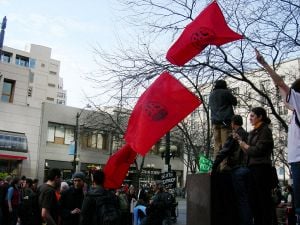
IWW organizing drives in recent years have included a major campaign to organize Borders Books in 1996, a strike at the Lincoln Park Mini Mall in Seattle that same year, organizing drives at Wherehouse Music, Keystone Job Corps, the community organization ACORN, various homeless and youth centers in Portland, Oregon, sex industry workers, and recycling shops in Berkeley, California. IWW members have been active in the building trades, marine transport, ship yards, high tech industries, hotels and restaurants, public interest organizations, schools and universities, recycling centers, railroads, bike messengers, and lumber yards.
The IWW has stepped in several times to help the rank and file in mainstream unions, including saw mill workers in Fort Bragg in California in 1989, concession stand workers in the San Francisco Bay Area in the late 1990s, and most recently at shipyards along the Mississippi River.
In the early 2000s the IWW organized Stonemountain and Daughter Fabrics, a fabric/seamstress shop in Berkeley. The shop has remained under contract with the IWW to this day.
In 2004, an IWW union was organized in a New York City Starbucks. And in 2006, the IWW continued efforts at Starbucks by organizing several Chicago area shops.[10] In September of 2004, IWW-organized short haul truck drivers in Stockton, California walked off their jobs and went on a strike. Nearly all demands were met. Despite early victories in Stockton, the truck drivers union ceased to exist in mid-2005. In Chicago the IWW began an effort to organize bicycle messengers with some success. Between 2003 and 2006, the IWW organized unions at food co-operatives in Seattle, Washington and Pittsburgh, PA. The IWW represents administrative and maintenance workers under contract in Seattle, while the union in Pittsburgh lost 22-21 in an NLRB election, only to have the results invalidated in late 2006, based on management's behavior before the election. Recent activity includes a sizeable industrial campaign among immigrant foodstuffs workers in New York City, and building a presence in Los Angeles by organizing short-haul truckers and taxi drivers.
The city of Berkeley's recycling is picked up, sorted, processed and sent out all through two different IWW organized enterprises.
Besides IWW's traditional practice of organizing industrially, the Union has been open to new methods such as organizing geographically: for instance, seeking to organize retail workers in a certain business district, as in Philadelphia.
The union has also participated in such worker-related issues as protesting involvement in the war in Iraq, opposing sweatshops and supporting a boycott of Coca Cola for that company's alleged support of the suppression of workers rights in Colombia.
In 2006 the IWW moved its headquarters to Cincinnati, Ohio.
Also in 2006, the IWW Bay Area Branch organized the Landmark Shattuck Cinemas. The Union has been negotiating for a contract and hopes to gain one through workplace democracy and organizing directly and taking action when necessary.
Current membership is about 2000 (about 900 in good standing), with most members in the United States, but many also located in Australia, Canada, Ireland, and the United Kingdom.
The IWW in Australia
Australia encountered the IWW tradition very early, with both Chicago and Detroit branches forming in Australia. In part this was due to the local De Leonist SLP following the industrial turn of the US SLP.
The Australian IWW developed in conditions of increasing industrial militancy after 1908. It first shot to prominence by opposing compulsory boyhood conscription in Australia. The early Australian IWW used a number of tactics from the US, including free speech fights.
The Australian IWW was most important, however, in terms of its industrial organising work. The IWW cooperated with many other unions, encouraging industrial unionism and militancy. In particular, the IWW's strategies had a large effect on the Australasian Meat Industry Employees Union. The AMIEU established closed shops and workers councils and effectively regulated management behaviour towards the end of the 1910s.
The IWW was well known for opposing the First World War from 1914 onwards, and in many ways was at the front of the anti-conscription fight (this time opposed to manhood conscription). A series of controversial newspaper cartoons, most notably, "Workers follow your leaders", led to notoriety and the attention of Australian Federal intelligence agencies. When a five pound note forgery scandal was followed by a series of arsons and threatened arsons in Sydney, the IWW was declared an illegal organisation by the Commonwealth government and its leadership arrested in NSW.
The IWW continued illegally operating with the aim of freeing its class war prisoners and briefly fused with two other radical tendencies–from the old Socialist parties and Trades Halls–to form a larval communist party at the suggestion of the militant revolutionist and Council Communist Adela Pankhurst. The IWW however left the CPA shortly after its formation, taking with it the bulk of militant industrial worker members.
By the 1930s the IWW in Australia had declined significantly, and took part in unemployed workers movements which were led largely by the now Stalinised CPA. In 1939 the Australian IWW had four members, according to surveillance by government authorities, and these members were consistently opposed to the second world war. (See files in National Archives of Australia)
Today the IWW still exists in Australia, in larger numbers than the 1940s, but due to the nature of the Australian industrial relations system, it is unlikely to win union representation in any workplaces in the immediate future.
"Bump me into parliament" is perhaps the most notable Australian IWW song.
The IWW in the UK
Syndicalists and radical unionists, such as James Connolly in the UK and Ireland have remained close to the IWW in the USA. Although much smaller than their North American counterparts, the BIROC (British Isles Regional Organising Committee) reported in 2006 that there were nearly 200 members in the UK and Ireland. Numbers have been steadily increasing since the 1990s, and in the year 2005-2006 numbers leapt up by around 25%.
Having been present in the UK in various guises since 1906, the IWW was present to varying extents in many of the struggles in the early decades of the twentieth century, including the UK General Strike of 1926 and the dockers' strike of 1947. More recently, IWW members were involved in the Liverpool dockers' strike that took place between 1995 and 1998, and numerous other events and struggles throughout the 1990s and 2000s, including the successful unionising of several workplaces, including support workers for the Scottish Socialist Party who hold some seats in the Scottish Parliament. In 2005, the IWW's centenary year, a stone was laid in a forest in Wales, commemorating the centenary, as well as the death of US IWW and Earth First! activist Judi Bari.
The IWW has launched a Website and has eight general branches and several organizing groups around the UK alongside two budding industrial networks for health workers and education workers and a job branch for support workers at the Scottish Parliament. The British Isles IWW publishes a magazine, 'Bread and Roses' and an industrial newsletter for health workers.
Folk music and protest songs
One feature of IWW followers from their inception is song. To counteract management sending in the Salvation Army band to cover up the Wobbly speakers, Joe Hill wrote parodies of Christian hymns so that union members could sing along with the Salvation Army band, but with their own purposes (for example, "In the Sweet By and By" became "There'll Be Pie in the Sky When You Die (That's a Lie)"). From that start in exigency, Wobbly song writing became legendary. The IWW collected its official songs in the Little Red Songbook and continues to update this book to the present time. In the 1960s, the American folk music revival in the United States brought a renewed interest in the songs of Joe Hill and other Wobblies, and seminal folk revival figures such as Pete Seeger and Woody Guthrie had a pro-Wobbly tone, while some were members of the IWW. Among the protest songs in the book are "Hallelujah, I'm a Bum", "Union Maid", and "I Dreamed I Saw Joe Hill Last Night". Perhaps the best known IWW song is "Solidarity Forever". The songs have been performed by dozens of artists, and Utah Phillips has performed the songs in concert and on recordings for decades. Other prominent I.W.W. song writers include Ralph Chaplin who authored "Solidarity Forever", and Leslie Fish.
The Finnish I.W.W. community produced several folk singers, poets and song writers, the most famous being Matti Valentine Huhta (better known as T-Bone Slim), who penned "The Popular Wobbly" and "The Mysteries of a Hobo's Life." Hiski Salomaa, whose songs were composed entirely in Finnish (and Finglish), remains a widely recognized early folk musician in his native Finland as well as in sections of the Midwest United States, Northern Ontario, and other areas of North America with high concentrations of Finns. Salomaa, who was a tailor by trade, has been referred to as the Finnish Woody Guthrie. Arthur Kylander, who worked as a lumberjack, is a lesser known, but important Finnish I.W.W. folk musician. Kylander's lyrics range from the difficulties of the immigrant labourer's experience to more humorous themes. Arguably, the wanderer, a recurring theme in Finnish folklore dating back to pre-Christian oral tradition (as with Lemminkäinen in the Kalevala), translated quite easily to the music of Huhta, Salomaa, and Kylander; all of whom have songs about the trials and tribulations of the hobo.
IWW lingo
The origin of the name "Wobbly" is uncertain. Many believe it refers to a tool known as a "wobble saw". One often repeated anecdote suggests that a Chinese restaurant owner in Vancouver would extend credit to IWW members and, unable to pronounce the "W", would ask if they were a member of the "I Wobble Wobble."[11] There are other possible explanations for the name.
For more information on the term Wobblies, an examination of "International" Workers of the World, and other IWW-related slang, see Wobbly lingo.
Notable members
Notable members of the Industrial Workers of the World have included Lucy Parsons; Helen Keller [12]; Joe Hill; Ralph Chaplin; Ricardo Flores Magon; James P. Cannon; James Connolly; Jim Larkin; Paul Mattick; Big Bill Haywood; Eugene Debs; Elizabeth Gurley Flynn; Sam Dolgoff, Indian Nationalist Lala Hardayal; Frank Little; ACLU founder Roger Nash Baldwin; Harry Bridges; Buddhist beat poet Gary Snyder; anthropologist David Graeber; graphic artist Carlos Cortez; counterculture icon Kenneth Rexroth; Surrealist Franklin Rosemont; Rosie Kane and Carolyn Leckie, former Members of the Scottish Parliament; Judi Bari; folk musicians Utah Phillips and David Rovics; mixed martial arts fighter Jeff Monson; Finnish folk music legend Hiski Salomaa; U.S. Green Party politician James M. Branum; Catholic Workers Dorothy Day and Ammon Hennacy; nuclear engineer Susanna Johnson. The former lieutenant governor of Colorado, David C. Coates was a labor militant, and was present at the founding convention,[13] although it is unknown if he became a member. It has long been rumored, but not yet proven, that baseball legend Honus Wagner was also a Wobbly. Senator Joe McCarthy accused Edward R. Murrow of having been an IWW member. The organization's most famous current member is Noam Chomsky.
See also
- Continental Congress of the working class, the first IWW convention
- Industrial unionism
- One Big Union
- Free speech fights
- General strike
- Bill Haywood
- Labor federation competition in the U.S.
- Wobbly lingo
- Anarcho-syndicalism
- History of the United States (1865-1918)
- American Protective League
- Socialist Party USA
- Industrial democracy
- Socialism
- Workplace democracy
- Silent agitators
- Black Cat
External links
- The IWW Home Page
- The IWW Organizing Department
- IWW Culture, History, and Library
- IWW Starbucks Workers Union
- Jim Crutchfield's IWW Page current and historical documents
- IWW in Australia
- IWW Canada in French
- IWW Canada in English
- IWW British Isles
- IWW German Language Area
- IWW 100 an IWW centenary tribute with historical and news articles
- IWW FAQ
- Howard Zinn, "The Founding Convention of the IWW", A People's History of the United States
- Howard Zinn, "Self-help in Hard Times", A People's History of the United States
- Paul Buhle, "The Legacy of the IWW", Monthly Review
- Account of the repression of the IWW in Chile
ReferencesISBN links support NWE through referral fees
- ↑ Preamble & Constitution of the Industrial Workers of the World, as amended through 1 January 2005.
- ↑ Finnish-American Workmen's Associations Auvo Kostiainen
- ↑ Spokane — Thumbnail History, at SpokaneHistory.org.
- ↑ (1986) One Big Union.
- ↑ "Although the exact circumstances are unknown, it is thought that both deputies were struck by friendly fire." Deputy Sheriff Jefferson F. Beard at the Officer Down Memorial Page.
- ↑ "Although the exact circumstances are unknown, it is thought that both deputies were struck by friendly fire." Deputy Sheriff Charles O. Curtiss at the Officer Down Memorial Page.
- ↑ Roughneck, The Life and Times of Big Bill Haywood, Peter Carlson, 1983, pages 241.
- ↑ Roughneck, The Life and Times of Big Bill Haywood, Peter Carlson, 1983, pages 242-244.
- ↑ See: http://www.findagrave.com/cgi-bin/fg.cgi?page=gr&GRid=5855116
- ↑ Philip Dawdy, A Union Shop on Every Block, Seattle Weekly, 7 December 2005 (accessed 24 September 2006).
- ↑ Mark Leier, Where the Fraser River Flows: The Industrial Workers of the World in British Columbia. Vancouver: New Star Books, 1990, 35, 54 n 8.
- ↑ [1]
- ↑ Roughneck: The Life and Times of Big Bill Haywood, Peter Carlson, 1983, pp. 78.
Further reading
Archives
- Industrial Workers of the World Collection predominantly, 1950s-1970s at the Walter P. Reuther Library of Labor and Urban Affairs.
- Documents, Essays and Analysis for a History of the Industrial Workers of the World. Online archive at the Marxists Internet Archive. Retrieved April 16, 2005.
Books
- Brissenden, Paul F. [1919] (1920. Reprinted by Russell & Russell, New York, 1957.). The IWW: A Study of American Syndicalism, 2nd edition, New York: Columbia University Press, 438 pages.
- Dubofsky, Melvyn [2000]. We Shall Be All: A History of the Industrial Workers of the World. University of Illinois Press, 288 pages Abridged. ISBN 0-252-06905-6.
- [1964] (1988) in Kornbluh, Joyce L., ed.: Rebel Voices: An IWW Anthology, Reprinted by Charles H. Kerr Co., Chicago, with new introduction and essays, Ann Arbor: University of Michigan Press, illustrated, 419 pages. ISBN 0-88286-237-5.
- McClelland, John, Jr. [1987]. Wobbly War: The Centralia Story (hardcover), Washington State Historical Society. ISBN 0-917048-62-8.
- Moran, William [2002]. Belles of New England: The Women of the Textile Mills and the Families Whose Wealth They Wove (hardcover), St. Martin's Press, 320 pages. ISBN 0-312-30183-9.
- in Buhle, Paul and Nicole Schulman, ed.: Wobblies: A Graphic History of the Industrial Workers of the World. Verso, 305 pages. ISBN 1-84467-525-4.
- St. John, Vincent [1917]. The I. W. W.: Its History, Structure & Methods. I. W. W. Publishing Bureau. Retrieved 2006-03-06.
- Thompson, Fred [1955]. The I. W. W.: Its First Fifty Years. Chicago: IWW.
- Rosemont, Franklin and Charles Radcliffe [2005]. Dancin' in the Streets: Anarchists, IWWs, Surrealists, Situationists and Provos in the 1960s as Recorded in the Pages of Rebel Worker and Heatwave. Charles H. Kerr. ISBN 0-88286-301-0.
- Rosen, Ellen Doree [2004]. A Wobbly Life: IWW Organizer E. F. Doree, Introduction by Melvyn Dubofsky, Detroit, Michigan: Wayne State University Press, 256 pages (includes bibliographical references and index). ISBN 0-8143-3203-X.
- Green, Archie [1993]. Wobblies, Pile Butts, and Other Heroes. University of Illinois Press, 534 pages. ISBN 0-252-01963-6.
- A large part of the trilogy U.S.A., which is considered the major work of John Dos Passos and which comprises The 42nd Parallel (1930), 1919 (1932), and The Big Money (1936), is devoted to a vivid and highly sympathetic description of the struggles waged by the IWW.
- Green, Archie, and David Roediger, Franklin Rosemont, and Salvatore Salerno, eds. [2007]. The Big Red Songbook. Charles H. Kerr, 538 pages. ISBN 0-88286-277-4
Documentary films
- The Wobblies. Directed by Stewart Bird, Deborah Shaffer, 1979. DVD 2006 NTSC English 90 minutes. (Includes interviews with 19 elderly Wobblies)
- An Injury to One. A Film by Travis Wilkerson, 2003 First Run Icarus Films. English 53 minutes. Chronicles the 1917 unsolved murder of Wobbly organizer Frank Little in Butte, Montana during a strike by 16,000 miners against the Anaconda Copper Company. The film connects "corporate domination to government repression, local repression to national repression, labor history to environmental history, popular culture to the history of class struggle," according to one review [2] .
- The Ghost of Hangman's Bridge. A feature film — currently in early development stages — about the state of Washington's Centralia Massacre, by Ursula Richards-Coppola, anticipated release 2009. For more information: http://www.ghostofhangmansbridge.com
Credits
New World Encyclopedia writers and editors rewrote and completed the Wikipedia article in accordance with New World Encyclopedia standards. This article abides by terms of the Creative Commons CC-by-sa 3.0 License (CC-by-sa), which may be used and disseminated with proper attribution. Credit is due under the terms of this license that can reference both the New World Encyclopedia contributors and the selfless volunteer contributors of the Wikimedia Foundation. To cite this article click here for a list of acceptable citing formats.The history of earlier contributions by wikipedians is accessible to researchers here:
The history of this article since it was imported to New World Encyclopedia:
Note: Some restrictions may apply to use of individual images which are separately licensed.
